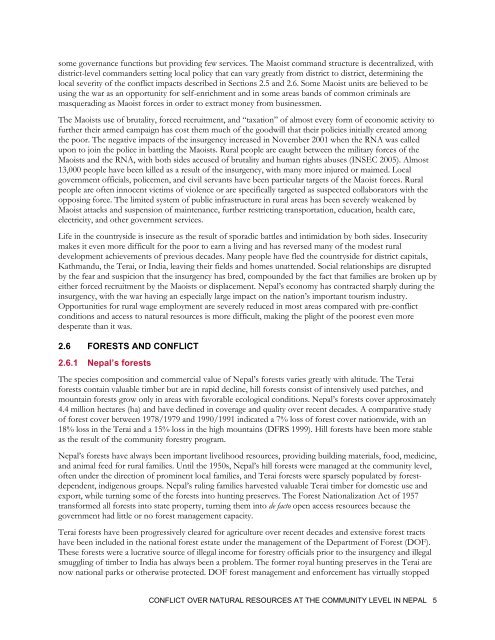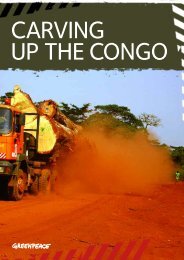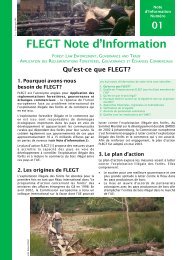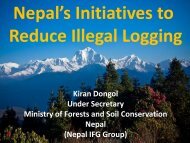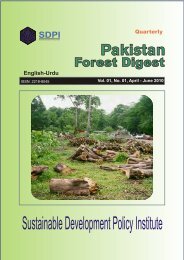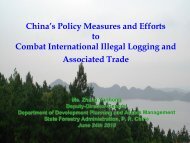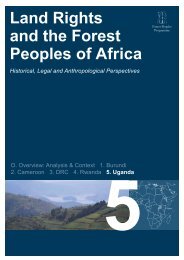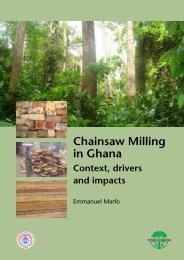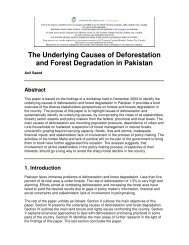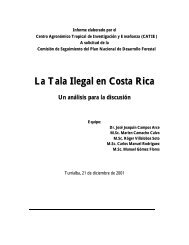conflict over natural resources at the community level in nepal
conflict over natural resources at the community level in nepal
conflict over natural resources at the community level in nepal
You also want an ePaper? Increase the reach of your titles
YUMPU automatically turns print PDFs into web optimized ePapers that Google loves.
some g<strong>over</strong>nance functions but provid<strong>in</strong>g few services. The Maoist command structure is decentralized, withdistrict-<strong>level</strong> commanders sett<strong>in</strong>g local policy th<strong>at</strong> can vary gre<strong>at</strong>ly from district to district, determ<strong>in</strong><strong>in</strong>g <strong>the</strong>local severity of <strong>the</strong> <strong>conflict</strong> impacts described <strong>in</strong> Sections 2.5 and 2.6. Some Maoist units are believed to beus<strong>in</strong>g <strong>the</strong> war as an opportunity for self-enrichment and <strong>in</strong> some areas bands of common crim<strong>in</strong>als aremasquerad<strong>in</strong>g as Maoist forces <strong>in</strong> order to extract money from bus<strong>in</strong>essmen.The Maoists use of brutality, forced recruitment, and “tax<strong>at</strong>ion” of almost every form of economic activity tofur<strong>the</strong>r <strong>the</strong>ir armed campaign has cost <strong>the</strong>m much of <strong>the</strong> goodwill th<strong>at</strong> <strong>the</strong>ir policies <strong>in</strong>itially cre<strong>at</strong>ed among<strong>the</strong> poor. The neg<strong>at</strong>ive impacts of <strong>the</strong> <strong>in</strong>surgency <strong>in</strong>creased <strong>in</strong> November 2001 when <strong>the</strong> RNA was calledupon to jo<strong>in</strong> <strong>the</strong> police <strong>in</strong> b<strong>at</strong>tl<strong>in</strong>g <strong>the</strong> Maoists. Rural people are caught between <strong>the</strong> military forces of <strong>the</strong>Maoists and <strong>the</strong> RNA, with both sides accused of brutality and human rights abuses (INSEC 2005). Almost13,000 people have been killed as a result of <strong>the</strong> <strong>in</strong>surgency, with many more <strong>in</strong>jured or maimed. Localg<strong>over</strong>nment officials, policemen, and civil servants have been particular targets of <strong>the</strong> Maoist forces. Ruralpeople are often <strong>in</strong>nocent victims of violence or are specifically targeted as suspected collabor<strong>at</strong>ors with <strong>the</strong>oppos<strong>in</strong>g force. The limited system of public <strong>in</strong>frastructure <strong>in</strong> rural areas has been severely weakened byMaoist <strong>at</strong>tacks and suspension of ma<strong>in</strong>tenance, fur<strong>the</strong>r restrict<strong>in</strong>g transport<strong>at</strong>ion, educ<strong>at</strong>ion, health care,electricity, and o<strong>the</strong>r g<strong>over</strong>nment services.Life <strong>in</strong> <strong>the</strong> countryside is <strong>in</strong>secure as <strong>the</strong> result of sporadic b<strong>at</strong>tles and <strong>in</strong>timid<strong>at</strong>ion by both sides. Insecuritymakes it even more difficult for <strong>the</strong> poor to earn a liv<strong>in</strong>g and has reversed many of <strong>the</strong> modest ruraldevelopment achievements of previous decades. Many people have fled <strong>the</strong> countryside for district capitals,K<strong>at</strong>hmandu, <strong>the</strong> Terai, or India, leav<strong>in</strong>g <strong>the</strong>ir fields and homes un<strong>at</strong>tended. Social rel<strong>at</strong>ionships are disruptedby <strong>the</strong> fear and suspicion th<strong>at</strong> <strong>the</strong> <strong>in</strong>surgency has bred, compounded by <strong>the</strong> fact th<strong>at</strong> families are broken up byei<strong>the</strong>r forced recruitment by <strong>the</strong> Maoists or displacement. Nepal’s economy has contracted sharply dur<strong>in</strong>g <strong>the</strong><strong>in</strong>surgency, with <strong>the</strong> war hav<strong>in</strong>g an especially large impact on <strong>the</strong> n<strong>at</strong>ion’s important tourism <strong>in</strong>dustry.Opportunities for rural wage employment are severely reduced <strong>in</strong> most areas compared with pre-<strong>conflict</strong>conditions and access to <strong>n<strong>at</strong>ural</strong> <strong>resources</strong> is more difficult, mak<strong>in</strong>g <strong>the</strong> plight of <strong>the</strong> poorest even moredesper<strong>at</strong>e than it was.2.6 FORESTS AND CONFLICT2.6.1 Nepal’s forestsThe species composition and commercial value of Nepal’s forests varies gre<strong>at</strong>ly with altitude. The Teraiforests conta<strong>in</strong> valuable timber but are <strong>in</strong> rapid decl<strong>in</strong>e, hill forests consist of <strong>in</strong>tensively used p<strong>at</strong>ches, andmounta<strong>in</strong> forests grow only <strong>in</strong> areas with favorable ecological conditions. Nepal’s forests c<strong>over</strong> approxim<strong>at</strong>ely4.4 million hectares (ha) and have decl<strong>in</strong>ed <strong>in</strong> c<strong>over</strong>age and quality <strong>over</strong> recent decades. A compar<strong>at</strong>ive studyof forest c<strong>over</strong> between 1978/1979 and 1990/1991 <strong>in</strong>dic<strong>at</strong>ed a 7% loss of forest c<strong>over</strong> n<strong>at</strong>ionwide, with an18% loss <strong>in</strong> <strong>the</strong> Terai and a 15% loss <strong>in</strong> <strong>the</strong> high mounta<strong>in</strong>s (DFRS 1999). Hill forests have been more stableas <strong>the</strong> result of <strong>the</strong> <strong>community</strong> forestry program.Nepal’s forests have always been important livelihood <strong>resources</strong>, provid<strong>in</strong>g build<strong>in</strong>g m<strong>at</strong>erials, food, medic<strong>in</strong>e,and animal feed for rural families. Until <strong>the</strong> 1950s, Nepal’s hill forests were managed <strong>at</strong> <strong>the</strong> <strong>community</strong> <strong>level</strong>,often under <strong>the</strong> direction of prom<strong>in</strong>ent local families, and Terai forests were sparsely popul<strong>at</strong>ed by forestdependent,<strong>in</strong>digenous groups. Nepal’s rul<strong>in</strong>g families harvested valuable Terai timber for domestic use andexport, while turn<strong>in</strong>g some of <strong>the</strong> forests <strong>in</strong>to hunt<strong>in</strong>g preserves. The Forest N<strong>at</strong>ionaliz<strong>at</strong>ion Act of 1957transformed all forests <strong>in</strong>to st<strong>at</strong>e property, turn<strong>in</strong>g <strong>the</strong>m <strong>in</strong>to de facto open access <strong>resources</strong> because <strong>the</strong>g<strong>over</strong>nment had little or no forest management capacity.Terai forests have been progressively cleared for agriculture <strong>over</strong> recent decades and extensive forest tractshave been <strong>in</strong>cluded <strong>in</strong> <strong>the</strong> n<strong>at</strong>ional forest est<strong>at</strong>e under <strong>the</strong> management of <strong>the</strong> Department of Forest (DOF).These forests were a lucr<strong>at</strong>ive source of illegal <strong>in</strong>come for forestry officials prior to <strong>the</strong> <strong>in</strong>surgency and illegalsmuggl<strong>in</strong>g of timber to India has always been a problem. The former royal hunt<strong>in</strong>g preserves <strong>in</strong> <strong>the</strong> Terai arenow n<strong>at</strong>ional parks or o<strong>the</strong>rwise protected. DOF forest management and enforcement has virtually stoppedCONFLICT OVER NATURAL RESOURCES AT THE COMMUNITY LEVEL IN NEPAL 5


